Abstract
Kinetic properties of rat liver pyruvate kinase type I at pH7.5 and 6.5 were studied with physiological ranges of substrates, modifiers and Mg2+ concentrations at increasing enzyme concentrations, including the estimated cellular concentrations (approx. 0.1mg/ml). Enzyme properties appear unaffected by increased enzyme concentration if phosphoenolpyruvate, fructose 1,6-diphosphate and inhibitors are incubated with enzyme before starting the reaction with ADP. Our data suggest that minimum cellular concentrations of MgATP and l-alanine provide virtually complete inhibition of pyruvate kinase I at pH7.5. The most likely cellular control of existing pyruvate kinase I results from the strong restoration of enzyme activity by the small physiological amounts of fructose 1,6-diphosphate. Decreasing the pH to 6.5 also restores pyruvate kinase activity, but to only about one-third of its activity in the presence of fructose 1,6-diphosphate. Neither pyruvate nor 2-phosphoglycerate at cellular concentrations inhibit the enzyme significantly.
Full text
PDF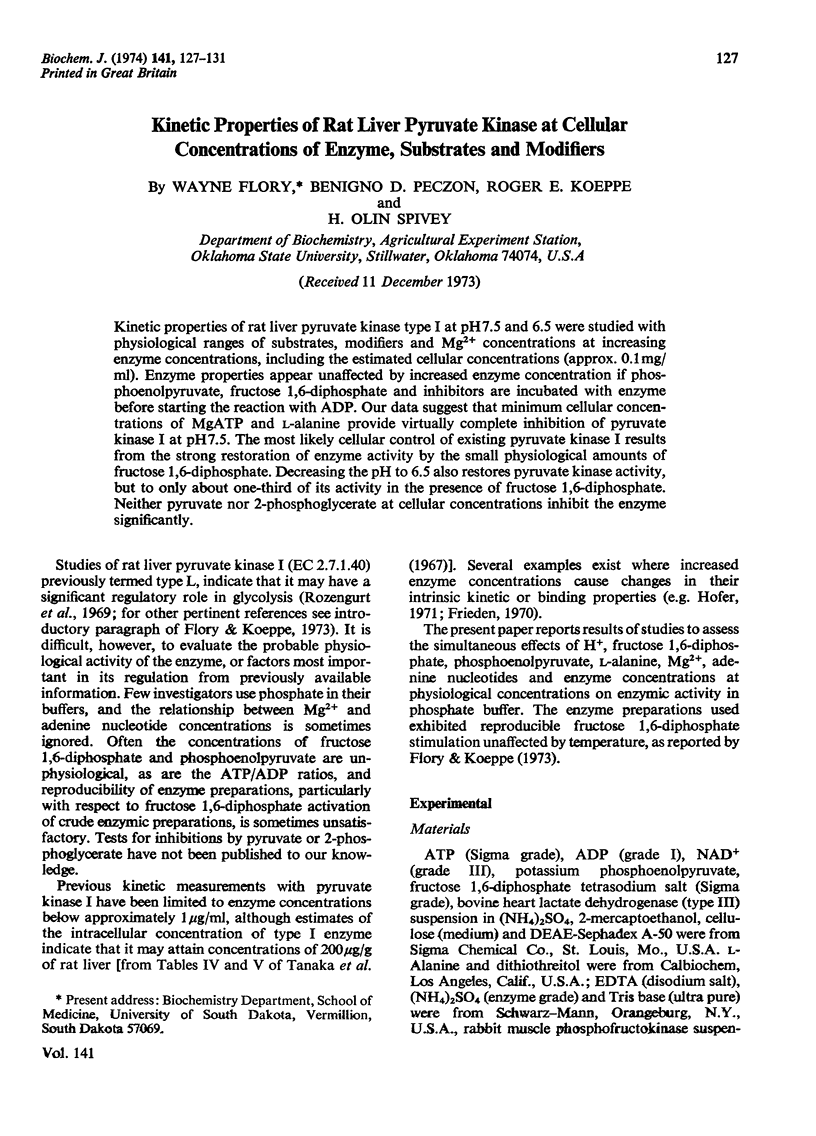
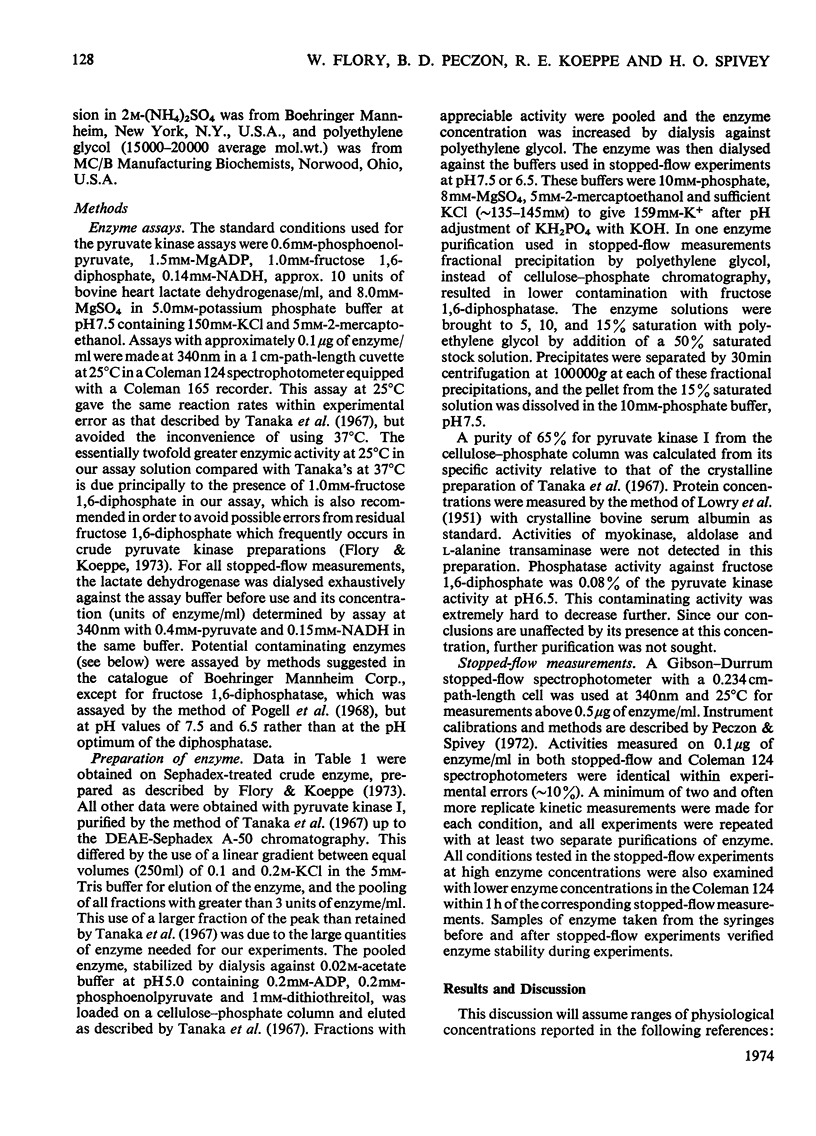
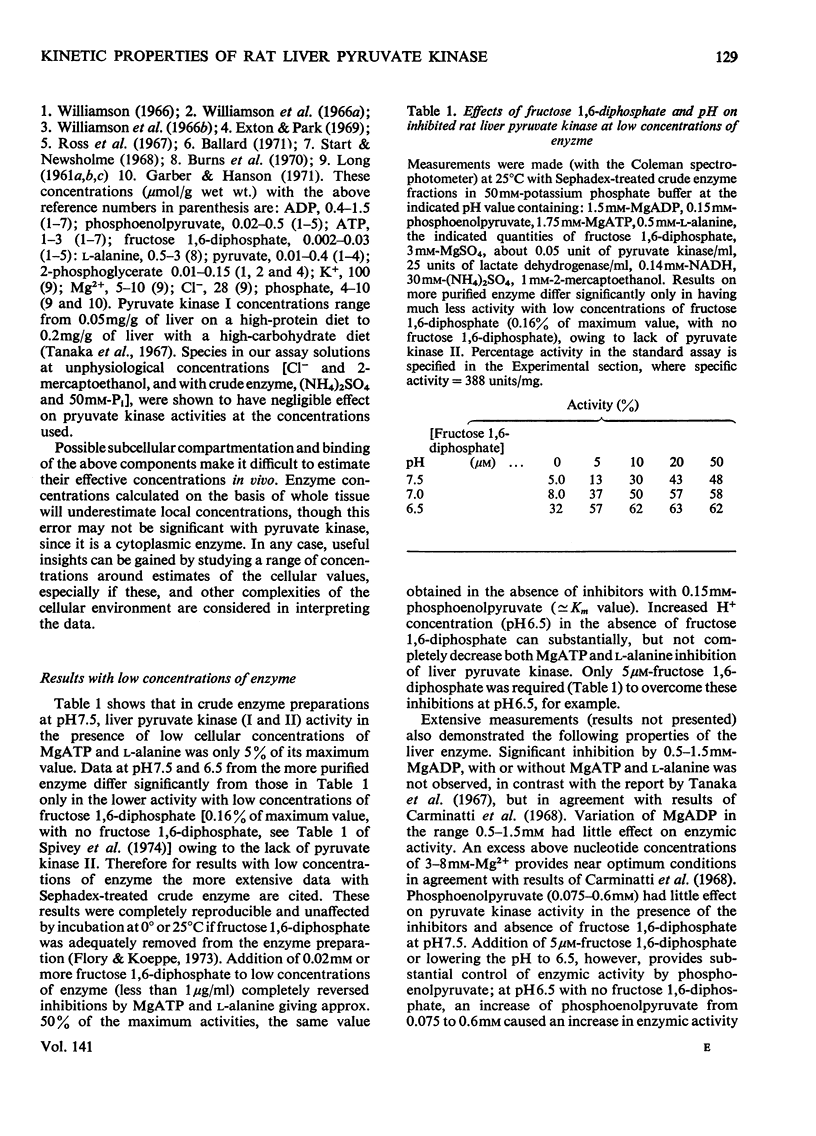
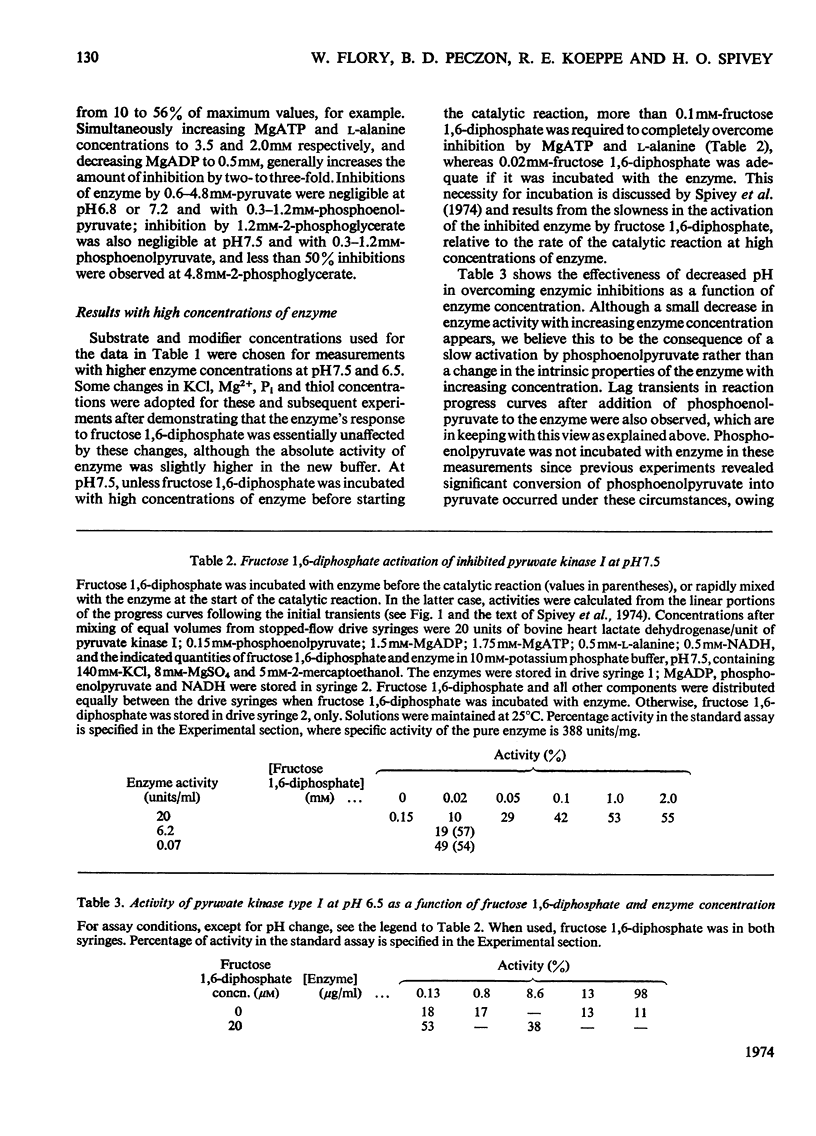
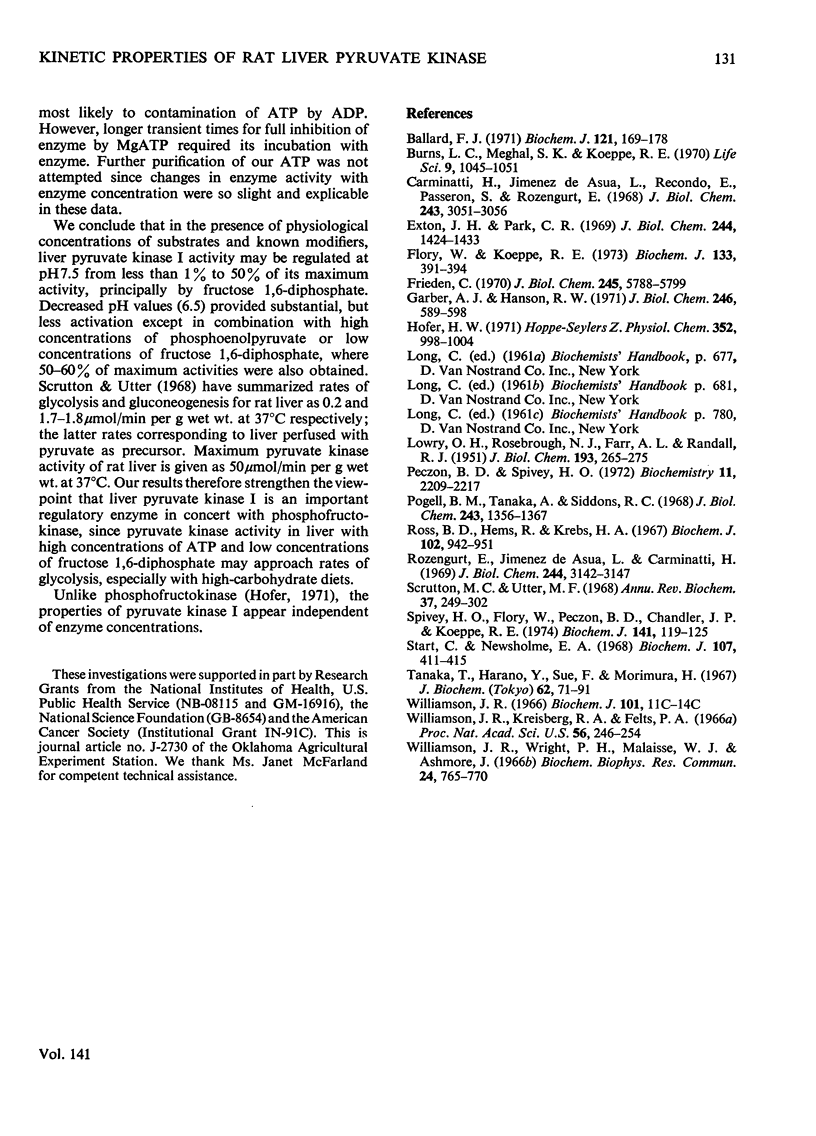
Selected References
These references are in PubMed. This may not be the complete list of references from this article.
- Ballard F. J. Regulation of gluconeogenesis during exposure of young rats to hypoxic conditions. Biochem J. 1971 Jan;121(2):169–178. doi: 10.1042/bj1210169. [DOI] [PMC free article] [PubMed] [Google Scholar]
- Burns L. C., Meghal S. K., Koeppe R. E. The effect of fasting and several hyperglycaemic agents on the free amino acids of rat liver. Life Sci II. 1970 Sep 22;9(18):1045–1051. doi: 10.1016/0024-3205(70)90013-5. [DOI] [PubMed] [Google Scholar]
- Carminatti H., Jiménez de Asúa L., Recondo E., Passeron S., Rozengurt E. Some kinetic properties of liver pyruvate kinase (type L). J Biol Chem. 1968 Jun 10;243(11):3051–3056. [PubMed] [Google Scholar]
- Exton J. H., Park C. R. Control of gluconeogenesis in liver. 3. Effects of L-lactate, pyruvate, fructose, glucagon, epinephrine, and adenosine 3',5'-monophosphate on gluconeogenic intermediates in the perfused rat liver. J Biol Chem. 1969 Mar 25;244(6):1424–1433. [PubMed] [Google Scholar]
- Flory W., Koeppe R. E. Lack of temperature-sensitivity of rat liver pyruvate kinase. Biochem J. 1973 Jun;133(2):391–394. doi: 10.1042/bj1330391. [DOI] [PMC free article] [PubMed] [Google Scholar]
- Frieden C. Kinetic aspects of regulation of metabolic processes. The hysteretic enzyme concept. J Biol Chem. 1970 Nov 10;245(21):5788–5799. [PubMed] [Google Scholar]
- Garber A. J., Hanson R. W. The interrelationships of the various pathways forming gluconeogenic precursors in guinea pig liver mitochondria. J Biol Chem. 1971 Feb 10;246(3):589–598. [PubMed] [Google Scholar]
- Hofer H. W. Influence of enzyme concentration on the kinetic behaviour of rabbit muscle phosphofructokinase. Hoppe Seylers Z Physiol Chem. 1971 Jul;352(7):997–1004. doi: 10.1515/bchm2.1971.352.2.997. [DOI] [PubMed] [Google Scholar]
- LOWRY O. H., ROSEBROUGH N. J., FARR A. L., RANDALL R. J. Protein measurement with the Folin phenol reagent. J Biol Chem. 1951 Nov;193(1):265–275. [PubMed] [Google Scholar]
- Peczon B. D., Spivey H. O. Catalytic sites in rabbit muscle glyceraldehyde-3-phosphate dehydrogenase. Their number and their kinetic and spectral properties. Biochemistry. 1972 Jun 6;11(12):2209–2217. doi: 10.1021/bi00762a001. [DOI] [PubMed] [Google Scholar]
- Pogell B. M., Tanaka A., Siddons R. C. Natural activators for liver fructose 1,6-diphosphatase and the reversal of adenosine 5'-monophosphate inhibition by muscle phosphofructokinase. J Biol Chem. 1968 Apr 10;243(7):1356–1367. [PubMed] [Google Scholar]
- Ross B. D., Hems R., Krebs H. A. The rate of gluconeogenesis from various precursors in the perfused rat liver. Biochem J. 1967 Mar;102(3):942–951. doi: 10.1042/bj1020942. [DOI] [PMC free article] [PubMed] [Google Scholar]
- Rozengurt E., Jiménez de Asúa L., Carminatti H. Some kinetic properties of liver pyruvate kinase (type L). II. Effect of pH on its allosteric behavior. J Biol Chem. 1969 Jun 25;244(12):3142–3147. [PubMed] [Google Scholar]
- Spivey H. O., Flory W., Peczon B. D., Chandler J. P., Koeppe R. E. Kinetics of the activation of rat liver pyruvate kinase by fructose 1,6-diphosphate and methods for characterizing hysteretic transitions. Biochem J. 1974 Jul;141(1):119–125. doi: 10.1042/bj1410119. [DOI] [PMC free article] [PubMed] [Google Scholar]
- Start C., Newsholme E. A. The effects of starvation and alloxan-diabetes on the contents of citrate and other metabolic intermediates in rat liver. Biochem J. 1968 Apr;107(3):411–415. doi: 10.1042/bj1070411. [DOI] [PMC free article] [PubMed] [Google Scholar]
- Tanaka T., Harano Y., Sue F., Morimura H. Crystallization, characterization and metabolic regulation of two types of pyruvate kinase isolated from rat tissues. J Biochem. 1967 Jul;62(1):71–91. doi: 10.1093/oxfordjournals.jbchem.a128639. [DOI] [PubMed] [Google Scholar]
- Williamson J. R., Kreisberg R. A., Felts P. W. Mechanism for the stimulation of gluconeogenesis by fatty acids in perfused rat liver. Proc Natl Acad Sci U S A. 1966 Jul;56(1):247–254. doi: 10.1073/pnas.56.1.247. [DOI] [PMC free article] [PubMed] [Google Scholar]
- Williamson J. R., Wright P. H., Malaisse W. J., Ashmore J. Control of gluconeogenesis by acetyl CoA in rats treated with glucagon and anti-insulin serum. Biochem Biophys Res Commun. 1966 Sep 8;24(5):765–770. doi: 10.1016/0006-291x(66)90391-3. [DOI] [PubMed] [Google Scholar]


